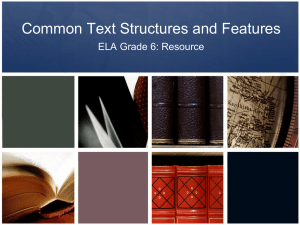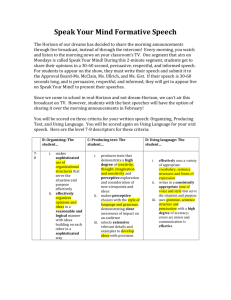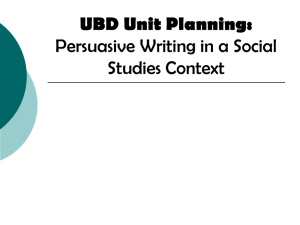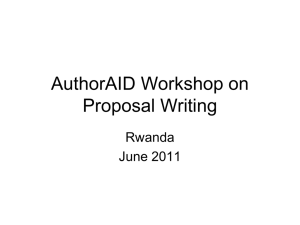Language Analysis
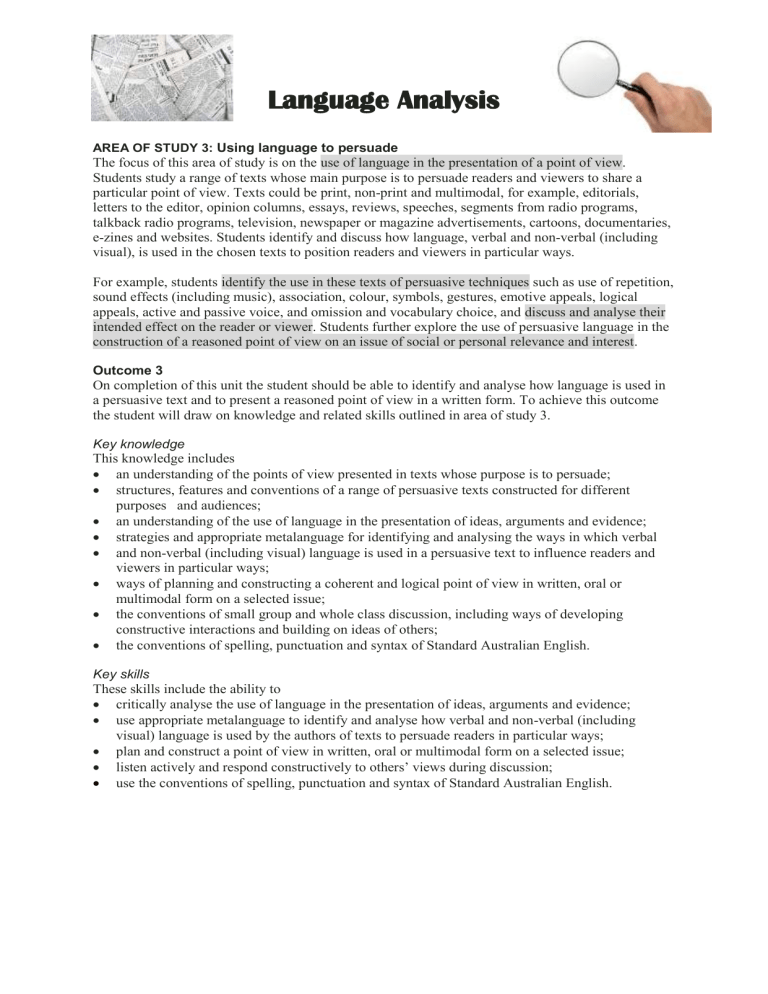
Language Analysis
AREA OF STUDY 3: Using language to persuade
The focus of this area of study is on the use of language in the presentation of a point of view.
Students study a range of texts whose main purpose is to persuade readers and viewers to share a particular point of view. Texts could be print, non-print and multimodal, for example, editorials, letters to the editor, opinion columns, essays, reviews, speeches, segments from radio programs, talkback radio programs, television, newspaper or magazine advertisements, cartoons, documentaries, e-zines and websites. Students identify and discuss how language, verbal and non-verbal (including visual), is used in the chosen texts to position readers and viewers in particular ways.
For example, students identify the use in these texts of persuasive techniques such as use of repetition, sound effects (including music), association, colour, symbols, gestures, emotive appeals, logical appeals, active and passive voice, and omission and vocabulary choice, and discuss and analyse their intended effect on the reader or viewer. Students further explore the use of persuasive language in the construction of a reasoned point of view on an issue of social or personal relevance and interest.
Outcome 3
On completion of this unit the student should be able to identify and analyse how language is used in a persuasive text and to present a reasoned point of view in a written form. To achieve this outcome the student will draw on knowledge and related skills outlined in area of study 3.
Key knowledge
This knowledge includes
an understanding of the points of view presented in texts whose purpose is to persuade;
structures, features and conventions of a range of persuasive texts constructed for different purposes and audiences;
an understanding of the use of language in the presentation of ideas, arguments and evidence;
strategies and appropriate metalanguage for identifying and analysing the ways in which verbal
and non-verbal (including visual) language is used in a persuasive text to influence readers and viewers in particular ways;
ways of planning and constructing a coherent and logical point of view in written, oral or multimodal form on a selected issue;
the conventions of small group and whole class discussion, including ways of developing constructive interactions and building on ideas of others;
the conventions of spelling, punctuation and syntax of Standard Australian English.
Key skills
These skills include the ability to
critically analyse the use of language in the presentation of ideas, arguments and evidence;
use appropriate metalanguage to identify and analyse how verbal and non-verbal (including visual) language is used by the authors of texts to persuade readers in particular ways;
plan and construct a point of view in written, oral or multimodal form on a selected issue;
listen actively and respond constructively to others’ views during discussion;
use the conventions of spelling, punctuation and syntax of Standard Australian English.
Language Analysis SAC Criteria (Marks awarded per criteria TBC)
1. Practise SAC
2. Exam (=Actual SAC)
Criterion 1
Knowledge and control of the chosen content and effectiveness and appropriateness of the exploration of ideas.
An understanding of the writer’s contention and how they have shaped
the piece to influence the reader
An understanding of how and why language has been used in the articles.
Discussion of language use in the presentation of the issue, showing awareness
of how writers use strategies to position readers in particular ways.
Criterion 2
Coherence and effectiveness of the structure and organisation of the writing.
A structure appropriate to the word length and form. ·
Effective and appropriate selection of ideas.
Coherent ordering and development of ideas.
Criterion 3
Control of the conventions of the English language.
Effective and accurate language appropriate to the specific purposes of the task.
Control of the mechanics of language to support meaning.
Expressiveness and fluency.
SAC Advice:
Explain how the text positions the audience.
Pay attention to Background Information
Analyse visuals not just describe
Don’t ignore obvious or repeatedly used techniques.
Comment on success of the texts NOT which is best.
Don't give your own opinion.
Identify contention
YOU MUST
Discuss CATFLAP for all pieces
Analyse the texts holistically not paragraph by paragraph.
Identify types of arguments [LEP, MEEPS, CLEE] Whoo hoo! More acronyms
Explain tone and why used. Does tone change?
Identify persuasive techniques and quote examples
EXPLAIN INTENDED EFFECT eg: The intention is to pull the heartstrings in order to persuade
us to donate.
Structure
Overall: Introduction – Analyse texts – Compare/Contrast texts – Conclusion
Paragraphs: identify argument – identify technique – give example – explain intended effect
Visuals: can be analysed along with the text [supporting contention or argument of written text] OR as a stand-alone paragraph [opposing a piece]
The SAC/Mid-year Exam
You could be given any number of persuasive pieces to analyse
For example:
One text FOR, one AGAINST, one image supporting one side
One text FOR, one AGAINST, two images supporting each side
A speech and TWO of the speaker’s Power Point slides.
One text, one image for/against the text
Types of persuasive images Types of persuasive pieces
Letter to the editor
Speech
Editorial
Blog
Opinion column
Poster
open letter
Essay
Review
Websites
Segments from radio program
Talkback radio program
Advertisements
Photo
Picture/Drawing
Cartoon
Caricature
Graphic
Symbol
Before you write, ask yourself about CATFLAP and include all this information briefly in your introduction.
CATFLAP
Contention
Audience
Tone
Form
Language
Purpose
Source
Introduction a) The source-date, title, where they were published and the form b) The background information on the issue c) The contention/stance of both pieces d) The tone used in both pieces and its effect
Paragraphs 1 piece A & Paragraph 2, piece B a) The Supporting arguments of the pieces b) Persuasive devices used to highlight the idea c) effect of persuasive devises used
Paragraph 3- Synthesis for both pieces a) What is similar in both b) What is different in both
Conclusion a) Which one is more effective?
b) Why?
LANGUAGE ANALYSIS ESSAY TIPS 101
Read the background information carefully, it is on the second page under Year 11 Exam Instructions. You need to be able to clearly outline the issue in the first two sentences of your introduction.
State the author’s full name in the introduction. From this point onwards only use the author’s surname and always use Capital letters for names! E.g., Kane
If you cannot tell the gender of the author, it doesn’t actually matter. Just pick one, either: male and female
(he/she) and stick to it throughout the entire essay.
Write in the present tense when discussing the article/s. E.g., “The author positions us to feel....” NOT “The author positioned us to feel...”
Use small quotes and integrate them into your own sentences. Instead of using large chucks or quotes, paraphrase with only small quotes of the most persuasive words.
Do not repeat information you have already talked about in previous paragraphs, you must have new points to talk about. Do not write a quote more than once. If you have to use it again just take the key words.
Use linking word/s for every paragraph! E.g., “In response”, “In contrast”, “Conversely”, “However”,
“Furthermore”, “On the other hand”, AND add linking words within your paragraphs E.g., “Whilst”,
“Whereas”, “Therefore” “Similarly”, “Following this” etc.
In your analysis of the second article, use “add-on” comments to compare back to the first. E.g., “In contrast to [AUTHOR A], [AUTHOR B] relies on a heavily emotive tone.” OR Similarly to [AUTHOR A], [AUTHOR B] begins with an anecdote.”
Don’t be afraid to discuss multiple techniques at once. E.g., “With a series of rhetorical questions the speaker elicits a more active involvement from her audience. The repetition of the phrase ‘Do we want...’ adds emphasis and momentum to this concluding part of the speech. Moreover the inclusive ‘we’ combines with the phrases ‘today Australia’ and ‘our values’ to appeal strongly to the audiences patriotism.”
Synthesis Paragraphs (Similarities and Differences) can be combined: However the fact that the authors have different contentions cannot be discussed as a point of difference in the synthesis paragraph. Rather focus on the different techniques and effects, the intended audiences (readership) and the different tones.
Watch clumsy wording and repetition. Make your points quickly and efficiently and then move on. Always be specific, do not make GENERAL statements about the techniques. State the actual technique, give example and explain the specific intended effect.
DO NOT use the word “says”, instead use – “states”, “reinforces”, “contends”, “explains”, “exposes”. E.g.,
“When Kane states ‘fashion is fun’, she reinforces...”
If there is a picture next to the article this is called a visual image and IS NOT imagery. Imagery is what is created in your mind from the words of the author.
Do not give your own thoughts/opinion about the issue in the conclusion. Stick to discussing which author was the most persuasive and why they were more persuasive.
HOLISTIC APPROACH-Different Types of Arguments
EPL: A General Summary of Aristotle's Appeals http://courses.durhamtech.edu/perkins/aris.htm
The Greek philosopher Aristotle divided the means of persuasion, appeals, into three categories--
Ethos, Pathos, Logos.
Ethos- (Greek for 'character') [Credibility] Refers to the trustworthiness or credibility of the writer or speaker. Ethos is often conveyed through tone and style of the message and through the way the writer or speaker refers to differing views. It can also be affected by the writer's reputation as it exists independently from the message--his or her expertise in the field, his or her previous record or integrity, and so forth. The impact of ethos is often called the argument's 'ethical appeal' or the 'appeal from credibility.'
Pathos- (Greek for 'suffering' or 'experience') [Emotional] means persuading by appealing to the reader's emotions. Is often associated with emotional appeal. An appeal to pathos causes an audience not just to respond emotionally but to identify with the writer's point of view--to feel what the writer feels. Pathos thus refers to both the emotional and the imaginative impact of the message on an audience, the power with which the writer's message moves the audience to decision or action.
Logos- (Greek for 'word') [Logical] means persuading by the use of reasoning. Refers to the internal consistency of the message--the clarity of the claim, the logic of its reasons, and the effectiveness of its supporting evidence. The impact of logos on an audience is sometimes called the argument's logical appeal.
Ethos: the source's credibility, the speaker's/author's authority
Logos: the logic used to support a claim can also be the facts and statistics
Pathos: the emotional/motivational appeals; vivid, emotional language and sensory details.
Or, if that’s all too hard-think of it as… CLEE
Credibility
Logic
Emotion
Evidence
Different types of arguments
(M.E.E.P.S.) Moral, Environmental, Economic, Practical, Societal
Moral – to do with right and wrong
KEY WORDS: unfair, wrong, unjustified, cruel, immoral unforgiveable, hypocritical
OR fair, right, justified, moral
Environmental – impact on the environment
KEY WORDS: damaging, harmful, polluting, destroy, wreck, OR clean, beneficial, productive, non-harmful
Economic – to do with money
KEY WORDS: expensive, costly, waste of money, waste of resources, OR inexpensive, cheap, cost-effective, wise
Practical – what will actually work?
KEY WORDS: unrealistic, won’t work, fail, impractical, difficult, impossible, poorly planned, OR practical, will work, carefully thought-out, wise, realistic
Societal – impact on people, health, families, or society
KEY WORDS: damaging, racist, sexist, unhealthy, destructive, will lead to unhappiness/violence/issues, OR healthy, beneficial, educational, values, happiness

